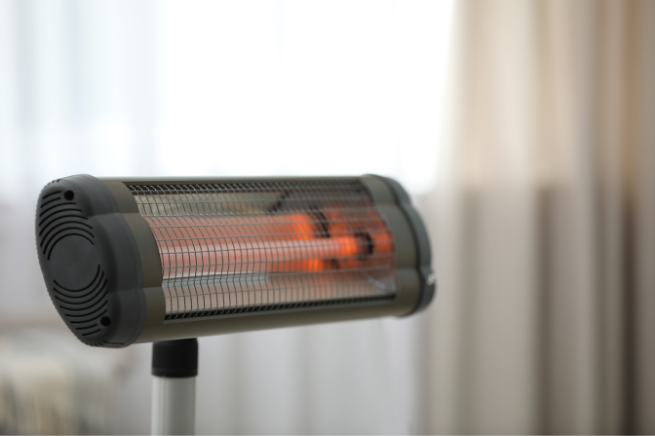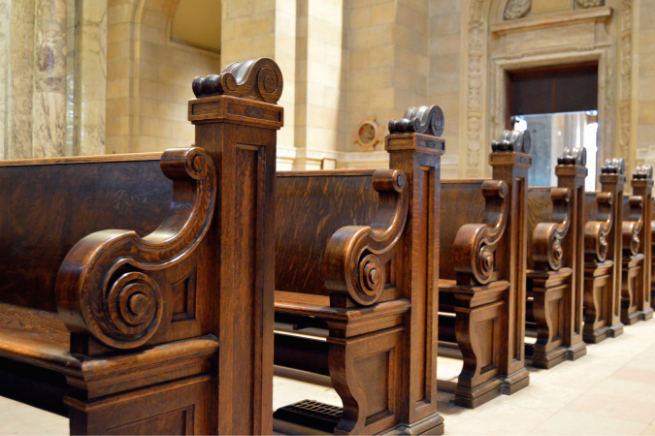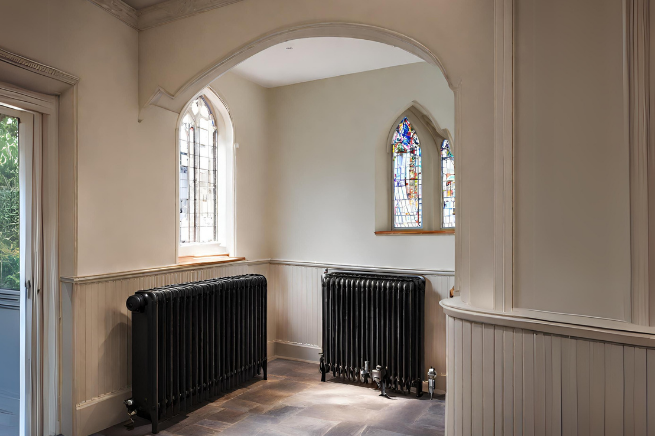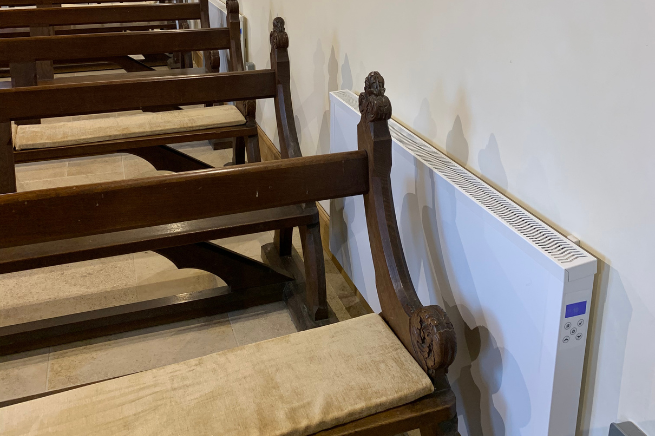
Imagine stepping into your church on a chilly morning and being greeted by a warm, comforting embrace. That’s the feeling we at Trust Electric Heating want to help you create. Your church isn’t just a building; it’s a community hub, a place of solace, and a beacon of warmth in more ways than one. Choosing the right heating system for you church is crucial, and at Trust Electric Heating understand the unique challenges that come with this decision.
Let’s talk about what your church needs in a heating system. It’s not just about keeping the place warm; it’s about making your congregation feel at home. Whether your church is cosy and quaint or grand and majestic, each church has its own story and requirements. And at Trust Electric Heating we’re here to listen and understand those unique needs. By focusing on both the charming architecture of your church and the practicality of energy efficiency, we aim to find a solution that feels just right. Our promise is to keep things simple and clear, ensuring you’re comfortable and confident every step of the way. Together, we’ll make sure your church is the warm, inviting sanctuary it’s meant to be.

It’s not rocket science; we all understand the primary purpose of church heating is to keep your church warm - that’s a given! However, it goes beyond just providing warmth. Church heating plays and important role in preserving the historic interiors of church buildings and ensuring the well-being of your congregants. Additionally, recent government initiatives, like the aim to achieve net-zero carbon emissions by 2030, have brought new challenges to the forefront.
For a deeper dive into these crucial topics, check out our latest church newsletter, where we discuss:
All about the 2030 Net Zero Carbon For Churches
Why your community building should transition to electric heating
How the NEOS can help you save on heating bills
PLUS: Advice and tips on how to access FREE Church Heating Funding.
Read the full newsletter to stay informed and make the best choices for your church.
But for now, let’s talk about how efficient central heating can impact your church:
First things first, a well-heated church is all about making everyone feel welcome and comfortable. Imagine stepping into a church that’s warm and inviting, rather than cold and drafty. It’s not just about comfort; it’s about helping everyone focus on the service, the music, and connecting with each other. The right temperature makes all the difference in creating a space where faith and fellowship thrive.
Many churches, especially historic buildings and traditional churches are treasures filled with history and art. Think about the classic stained glass windows and vintagewooden pews. Keeping these beauties in great shape means finding that sweet spot with the temperature. Too hot or too cold, and you risk harming these irreplaceable pieces of history. The right heating system can play a big part in preserving your church’s historic interiors.
A cosy church isn’t just about comfort; it’s about caring for the congregation’s health, especially for our elderly friends. A well-heated space can ward off cold-related health issues, ensuring everyone can enjoy the services in comfort and warmth. Furthermore, a warm church fosters community engagement, serving as a year-round hub for social gatherings, events, and outreach activities, thanks to lower running costs and energy-efficient electric heating.
In today’s world of renewable energy, every little bit helps in the fight against climate change, and churches have a role to play here too. Traditional heating methods might keep us warm but can harm our planet. But hey, there’s good news! Switching to energy-efficient electric heaters can reduce our carbon footprint, lower energy bills, and set a positive example for the community. It’s about being warm and wise, aligning our faith with our responsibility to the Earth.
We completely understand that when it comes to heating systems for your church, the options can seem overwhelming. But here’s the good news: we’ve got your back. We’ve done our homework to make your decision-making as easy as pie.
You might have heard of tried-and-true choices like an infrared heater, space heaters or pew heaters. They’re the classics, after all. But here’s the scoop: there are some other heating solutions out there that could be real game-changers. Not only can they keep your church warm and toasty, but they also come with the bonus of boosting energy efficiency and cutting down on those pesky running costs.
So, let’s dive into the world of church heating together. We’ll take you through the different heating systems made with churches in mind, and we’ll spill the beans on what’s great about each one and where they might have flaws. It’s all about giving you the lowdown to help you make the best choice for your church. After all, it’s your comfort, your budget, and your congregation that matter most.

Infrared heaters rank among the favoured options for church heating. They deliver swift, focused warmth, much like having your own cosy corner of warmth inside your church.
Here’s how they work: they emit infrared radiation, which is a safe and gentle type of electromagnetic radiation. Think of it as a cosy, invisible hug that directly warms people and objects in its path. These infrared heaters are pretty efficient, quickly delivering heat right where you want it without losing much to the air around. This means they’re not only good at keeping you warm but also at keeping your energy bills down.
And guess what? They’re super quiet. When you’re in the middle of a church service or a quiet moment of reflection, the last thing you want is a noisy space heater. Infrared heaters won’t disturb the peace.
You might be wondering if there’s a downside, and indeed, like most heating systems there is. Although infrared heaters excel at warming objects directly in their path, their coverage area is somewhat limited. This means in a big church or one with very high ceilings or an intricate design, they might not get the warmth everywhere. You might find some spots are toasty, while others are a bit chilly.
Let’s break down these pros and cons of infrared heaters:
Instant warmth.
Directly heats people and objects.
Energy-efficient, reducing your heating bills.
Silent operation.
Limited reach.
Not suitable for large spaces.
Uneven warmth.
Supplementary heaters needed to heat the whole church.

Looking to focus on heating the seating area specifically? Pew heaters are designed to provide warmth precisely where your congregation sits. Imagine stepping into the church on a cold day and feeling a gentle warmth as you take your seat. That’s the cosy magic of pew heaters.
What these heaters do is pretty straightforward: they focus their warmth on the seating areas, like a warm embrace for everyone sitting down. It’s all about making sure folks feel comfortable and cosy during services and events. They’re usually tucked under or near the pews, and the best part? You can adjust the heat to just the right level – perfect for those chilly winter services or cooler summer mornings.
Curious about their pros and cons?
Direct heat for pews.
Save on your energy bills by only heating specific areas when needed.
Adjustable controls.
Only heat the pews.
Setting them up initially might be a bit of an investment.
Maintenance required.

Let’s chat about gas heating systems. They’ve been a go-to for many churches, known for quickly warming up the place and keeping it nice and toasty during services and gatherings. If you’re considering one for your church, whether it’s a modern building or a historical gem, it’s important to weigh the pros and cons, keeping in mind both your heating needs and the environmental impact.
But here’s the thing we need to talk about: the not-so-great parts, especially for churches. First off, gas heaters do their job by burning natural gas, which means they’re not exactly friends of the environment. They release carbon emissions, and that’s a big concern with climate change on everyone’s mind. As a church, you’re all about making positive impacts, right? So, this bit about gas heaters might not align with those community-loving values.
And then there’s the cost factor. While gas might seem cost-effective at first, these systems usually need to keep running to stay effective, and a lot of that heat can end up warming the back wall instead of your congregation. This means higher running costs, which can add up, especially when you’re trying to be smart with your church’s budget. Additionally, if your church doesn’t already have a gas system in place, you may need to invest in plumbing and boiler work, which can involve additional expenses.
Plus, there’s this big move by the UK government aiming for net-zero by 2035, which includes phasing out gas heating systems. That could mean extra costs down the line for switching systems. Delaying the transition could potentially result in extra heating costs further down the line when you eventually have to make the switch.
But for now we will go through the positives and negatives of a gas heating system:
Quick warmth.
Usually not too complicated to get them set up.
Using natural gas can be cost-effective for generating heat.
They’re not eco friendly.
High operational costs due to no zone control and continuous running.
With the UK’s 2035 net-zero target, you might face additional costs for switching away from gas heating later.

Think of a cold Sunday morning, and imagine how nice it would be if your church was toasty and inviting. That’s where electric radiators come in. These handy electric heaters are great at using electricity to make your church feel just right. What’s even more convenient is that you can program electric radiators to align with your church’s service schedule. They’re like that clever friend who always knows how to make everyone comfortable.
What’s really neat about these electric radiators is they’re not just about making things warm. They’re smart too! Models like the NEOS, store heat within their core and release this without using any extra electricity, making them a energy efficient and cost-effective choice. And with easy-to-use controls and thermostats, you can set them just how you like, making sure the church is warm exactly where and when you want it. After all, there’s no point heating the entire church if you’re only using one room.
Let’s talk about the advantages and disadvantages of electric heating.
They’re big on energy efficiency, which means keeping warm doesn’t have to mean big bills.
Precise control with thermostats allows you to focus warmth exactly where it’s needed, when it’s needed.
They adapt to a variety of church sizes and styles, meeting diverse heating needs.
Expect cost savings, especially with models like our NEOS, which run at 50% lower costs compared to other heaters.
Overall, they amplify the comfort of your congregation, making your church a snug retreat.
The key is picking the right one – not all electric heaters are the same. For more tips, dive into our blog on different electric heating systems.
Some models might lose about 40% of their heat to the back wall, but that’s not the case with all. That’s where our NEOS electric radiator shines. It’s innovatively designed to minimise heat loss and offers 50% lower running costs than many other models – a real game-changer for your church.

Just as the name suggests, underfloor heating does precisely what it says on the box – it heats your space from beneath the floor. Underfloor heating creates a warm welcome for everyone, right from the ground. This innovative way of heating involves a network of pipes or electrical elements discreetly tucked beneath your floor. What makes it special is its ability to evenly spread warmth across the entire floor surface. The result? A consistent, gentle warmth that fills your church space from corner to corner, ensuring everyone feels comfortable and cosy.
So what are the pros and cons?
Even, comfortable temperature.
Discreet.
Damage to existing floor.
Expensive to install.
Pre-heating may be needed.

While we’ve explored several heating options, let’s shine some light on our NEOS electric radiator, a popular choice we’ve successfully installed in numerous churches. The NEOS stands out for its exceptional efficiency and adaptability, making it a preferred solution for spaces that require a thoughtful approach to heating.
Our process begins with a visit from one of our expert heating advisors. They’ll explore your church’s unique layout, truly understand your heating requirements, and recommend the optimal setup for your NEOS electric radiators. With this tailored approach, we ensure your church enjoys efficient, cost-effective heating, banishing those pesky cold spots and drafts once and for all.
Why choose the NEOS over other electric radiators?
The NEOS stands apart from standard electric radiators, thanks to its unique blend of innovative features and sleek design. Let’s go over these in detail:
Aluminium Casing: 2.9x More Conductive Than Mild Steel - The NEOS radiator’s aluminium casing is much better at conducting heat compared to the mild steel used in most other electric radiator designs. This means that the NEOS can warm up your church more effectively and quickly.
Soapstone Core Efficiency: The NEOS radiator utilises a soapstone core known for heat retention, enabling it to release warmth without continuous electricity. For example, it only needs about 10.28 hours of electricity to provide heat for a full day, although in reality, you won’t be heating your church continuously for a full 24 hours, resulting in higher energy efficiency and cost savings.
Patented Quadvex Technology: The NEOS radiator incorporates a patented Quadvex technology, setting it apart from other models. This innovative technology significantly improves heat distribution by increasing the points of convection from 1-2 to 4. It achieves this through serpentine convection, cool wall technology, and dual convection. These advanced features work in harmony to provide maximum heat output in a shorter time while minimising heat loss to the back wall, ultimately leading to substantial savings of up to 59% on your heating bills. Read more about this here.
Proudly Made in Britain: The NEOS radiator is manufactured in Britain, which means it’s crafted with the quality and craftsmanship associated with British products.
25-Year Guarantee: When you choose the NEOS radiator, you get the peace of mind of a 25-year guarantee, ensuring that your investment is protected for an extended period.
Knowledge Transfer Partnership with the University of Huddersfield: The NEOS radiator has undergone thorough testing and development in collaboration with the University of Huddersfield. You can read more about this here.
So now you know all about the heating options for your church, how do you choose your new system? Well lucky for you we have some tips! When choosing the right heating system for your church, consider the following factors:
Consider the building characteristics, unique layout, size, and use of your church.
Balance the installation costs with ongoing operational expenses.
Seek out energy-efficient options for environmental and financial benefits.
For historic buildings, choose a system that complements the architectural integrity.
Focus on providing a consistently comfortable temperature for your congregation.
Selecting the ideal heating system for your church is a decision of great importance. At Trust Electric Heating, we’re here to make this choice as straightforward as possible, catering to your unique needs.
Church heating isn’t just about warmth; it encompasses safeguarding historical elements, ensuring well-being, and aligning with the UK government’s net-zero carbon objectives for 2030. For a deeper understanding, explore our informative church newsletter, offering insights and valuable advice.
Tags: General Guides, Commercial.

If you are considering electric heating/electric radiators, then this guide tells you everything you need to know. Discover this modern, sustainable and economical method of heating that gives you complete control and comfort. Download Free Guide now.

*Trust Electric Heating needs the contact information you provide to us to contact you about our products and services. You may unsubscribe from these communications at any time. For information on how to unsubscribe, as well as our privacy practices and commitment to protecting your privacy, check out our Privacy Policy.
Quick installation and a 100 day warmth guarantee. Whether you’re buying one or several radiators, if our radiators don’t heat your room to a minimum of 20 degrees we will undertake to upgrade or replace the radiators free of charge.
Book your free consultation